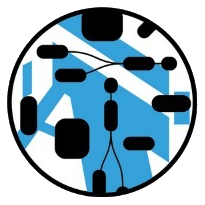 drawio
drawio
| Version: |
org.nasdanika.cli@2025.12.0
|
|---|
Usage: nsd drawio [-fhV] [-b=<baseUri>] [-p=<String=String>]... [-P=URL]...
[-u=<String=String>]... [-U=URL of URI to URL mapping
resource]... <document> [COMMAND]
Loads Drawio document from a URI or file
<document> Document URI or file path, resolved relative
to the current directory
-b, --base-url=<baseUri> Base URI for reolving document and target
URIs. Defaults to the current directory URI
Resolved relative to the current directory URI
-f, --file Document parameter is a file path
-h, --help Show this help message and exit.
-p, --property=<String=String>
Property
-P, --properties=URL Properties resource URL relative to the current
directory. YAML, JSON, or properties. Type is
inferred from the content type header, if it is
present, or extension. Properties are loaded in
the order of definition, later properties
replacing the former
-u, --uri=<String=String> URI mapping.
Target URIs are resolved
relative to the base URI
-U, --uris=URL of URI to URL mapping resource
URI map resource URL relative to the document file
YAML, JSON, or properties
Type is inferred from the content type header, if
it is present,
or extension
-V, --version Print version information and exit.
Commands:
- html-app - Generates html application model from a drawio document
- http-server - Routes HTTP requests to a diagram element processor
- invoke - Creates an Invocable dynamic proxy from a diagram
- save - Saves diagram to a file
- to-model - Converts diagram to diagram model
Examples
drawio test-data/jira/diagram.drawio html-app -r test-data/jira/root-action.yml --add-to-root site -r=-1 -F test-data/jira/page-template.yml test-data/jira/docsdrawio test-data/drawio-http/diagram.drawio http-server --http-port=8080 processor route- Loads
test-data/drawio-http/diagram.drawiodiagram resource - Executes http-server sub-command which serves diagram element routes at port
8080
- Loads
drawio -p my-property="My property" test-data/invocable.drawio invoke 33 66- Sets property
my-propertytoMy property - Loads
test-data/invocable.drawiodiagram document - Executes invoke sub-command with
33and66arguments
- Sets property
URI Handlers
The command loads URI Handlers using the capability framework. You can load resources from Maven with the Maven URI Handler. You can also create and register a custom URI handler, for example GitLabURIHandler to load diagram resources from GitLab. Below is an example of a capability factory:
import org.eclipse.emf.ecore.resource.URIConverter;
import org.eclipse.emf.ecore.resource.URIHandler;
import org.nasdanika.capability.emf.URIConverterContributorCapabilityFactory;
import org.nasdanika.common.ProgressMonitor;
/**
* Contributes {@link URIHandler} loading from Maven repositories
*/
public class MavenURIHandlerCapabilityFactory extends URIConverterContributorCapabilityFactory {
@Override
protected void contribute(
URIConverter uriConverter,
Loader loader,
ProgressMonitor progressMonitor) {
uriConverter.getURIHandlers().add(0, new MavenURIHandler(loader.getCapabilityLoader(), progressMonitor));
}
}
Contributing sub-commands
To contribute a sub-command:
- Add
@ParentCommands(Document.Supplier.class)annotation to your command class - Declare a field of type
Document.Supplierand annotate it with@ParentCommand. You may declare a setter method instead. - Use the field value to obtain an instance of
Document.
as shown in the code snippet below:
import org.nasdanika.cli.ParentCommands;
import org.nasdanika.common.ProgressMonitor;
import org.nasdanika.drawio.Document;
import picocli.CommandLine.Command;
import picocli.CommandLine.ParentCommand;
@Command(...)
@ParentCommands(Document.Supplier.class)
public class MyCommand {
@ParentCommand
private Document.Supplier documentSupplier;
public void myMethod(ProgressMonitor progressMonitor) {
Document document = documentSupplier.getDocument(progressMonitor);
...
}
}
Below is a factory:
import java.util.List;
import java.util.concurrent.CompletableFuture;
import java.util.concurrent.CompletionStage;
import org.nasdanika.common.ProgressMonitor;
import picocli.CommandLine;
public class MyCommanddFactory extends SubCommandCapabilityFactory<MyCommand> {
@Override
protected Class<MyCommand> getCommandType() {
return MyCommand.class;
}
@Override
protected CompletionStage<MyCommand> doCreateCommand(
List<CommandLine> parentPath,
Loader loader,
ProgressMonitor progressMonitor) {
return CompletableFuture.completedStage(new MyCommand(loader.getCapabilityLoader()));
}
}
The factory shall be registered as a CapabilityFactory provider in module-info.java:
import org.nasdanika.capability.CapabilityFactory;
module <module name> {
...
opens <package with commands>; // For reflection and documentation resource loading
provides CapabilityFactory with MyCommandFactory;
}
Executable diagrams sub-commands
You can create sub-commands which execute diagrams by extending AbstractElementInvocableCommand. invoke is an example of such a command. General purpose executable graphs and diagrams Medium story explains how to create diagram element processors.
 Nasdanika
Nasdanika